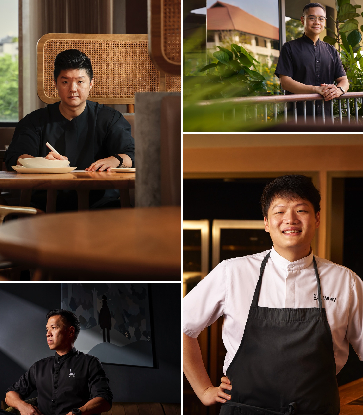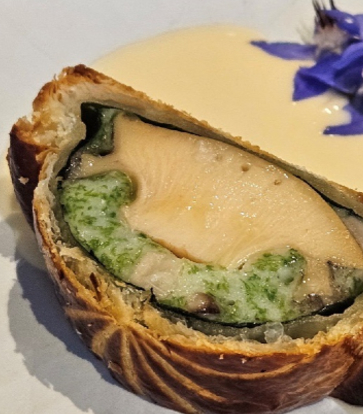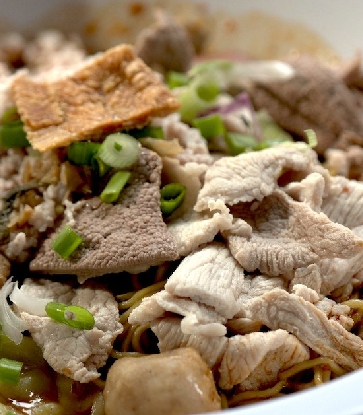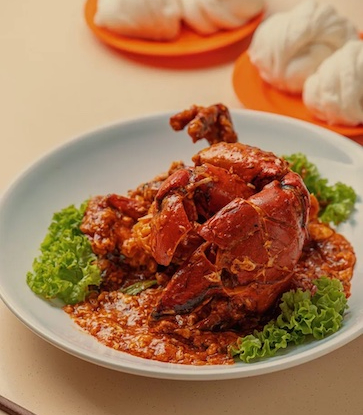Shi Le Po produces five types of potato chip and fish skin snacks in local flavours such as salted egg yolk. They are also available in spicy versions. In July, the brand rolled out its latest flavour, Ginger And Spring Onion Fish Skin, which is inspired by stir-fried fish slices with ginger and spring onion, a popular zichar dish.
The snack has crispy shards of fried fish skin chips tossed with ginger strips and spring onion. On Shi Le Po’s latest creation, Yam says in Mandarin: “I prefer to use ‘old’ ginger in this snack, which is spicier and more aromatic, and gives a more robust punch of flavours.”

Yam says: “Zichar is a unique part of Singapore’s food culture, and I want to showcase these home-grown flavours around the world through snacks that travellers can associate with Singapore.”
With Shi Le Po’s focus on Singapore flavours, its name is also a play on the Chinese translation of one of the names of old Singapore. Keeping to the local theme, the snack’s packaging is emblazoned with bright patterns reminiscent of Peranakan tiles.
The snack company was started by three foodie friends including Yam, who also helms Chinese restaurant Yam’s Kitchen in Downtown East. The team is constantly innovating and two other snacks, which are inspired by zichar dishes, are in the pipeline.
Growing up in Ipoh, Yam’s childhood revolved around hearty feasts whipped up by his housewife mother for his family of seven. He recalls: “My mum poured her heart and soul into her cooking and that inspired me to take up cooking as a career as I want to pass on this slice of warmth through food.” His favourite dishes include Hakka niang doufu and steamed fish stuffed with meat. Together with his siblings, he was also roped in by his mother to make more than 30 types of confections including Nonya kueh, bak zhang, ang ku kueh and chwee kueh during family gatherings and celebrations.

One of the highlights of his cooking career is snagging a gold medal at an international culinary competition in China in 2009 with his winning dish of steamed red snapper fish tail glazed with Nonya sauce, chinchalok, curry powder and freshly pressed lime juice. The dish is one of the signature dishes at Yam’s Kitchen today.
These days, Yam’s culinary creations have spread their wings across several overseas markets.
In Singapore, about 60 per cent of its sales are from tourists, who buy them as food souvenirs. The snacks are sold in retail shops in Changi Airport and in NTUC FairPrice supermarkets islandwide.
1. You started out as a chef in a Chinese restaurant, so how did you get into the snacks industry?
It started during a trip to Hong Kong in 2008 when I saw people dipping deep-fried fish skin in the hot pot broth. I was fascinated by such a peculiar practice and bought some packets to cook in my restaurant in Singapore. As the salted egg yolk flavour was starting to get trendy, I decided to fry the fish skin with salted egg yolk sauce and offered it as a complimentary side dish for diners.
The dish became so popular that I got numerous requests from customers to make it into a snack. Gradually, I bottled the salted egg yolk fish skin and sold it in limited quantity in the restaurant. The bottles were all snapped up quickly whenever a fresh batch was produced and I saw that there was a great potential in selling salted egg yolk fish skin as a snack.
2. As a chef-turned-snack-maker, what do you bring to Shi Le Po that is different from other brands on the market?
I place a strong emphasis on using self-concocted condiments and seasonings in my snacks. Through my decades of cooking experience and knowledge, I add ingredients such as salted egg, curry leaves, chilli padi and margarine — one step at a time — into the industrial-grade rotary woks to stir-fry the fried fish skin, instead of using pre-made seasonings. Besides using good ingredients, I approach creating a snack like how I would cook a dish in my restaurant.

3. How different is your approach to creating snacks as compared to whipping up a dish in a restaurant?
When I am cooking in a restaurant, I am working with fresh ingredients and can get feedback from customers almost immediately if I need to tweak a dish. However, when it comes to producing snacks, it is a longer and more complex process, and it is so much tougher than cooking in a kitchen.
As a snack-maker, my main aim is to ensure a consistent quality of snacks that are produced on a large scale. The research and development process can take months and it is more about trouble-shooting which part of the production process went awry. There can be a host of factors involved, from the ingredients to the cooking temperature in the multifaceted process. The main challenge lies in picking out the fault in the production process.
We have experimented with four types of fish skin: snakehead (toman), salmon, cod and dory. We settled on using dory fish skin, which is pre-fried in Vietnam. The supply of dory is high in this region due to high demand in the Asian market and dory has a less fishy taste. The snakehead’s skin is too thick and does not yield much crispiness when it is fried. Cod skin has a paper-like texture that does not have much bite. The shelf life of salmon is short, which is not a good quality for making snacks.

5. What is the biggest challenge that you face in the snack production process?
It is crucial that the snacks are crispy when customers take them out of the packet. In our factory in Singapore, we prepare the fish skin in industrial-grade rotary woks.
We cook the fish skin in each batch at 200° C in the fryer. The temperature and timing are vital as they affect the crispiness of the chips.
After the chips are tossed with the seasonings, we bake them in the oven to prolong their crispiness. We use an infra-red food safety thermometer to ensure that each chip is at 40 to 45° C just before the chips are packed in aluminium foil packaging.






















